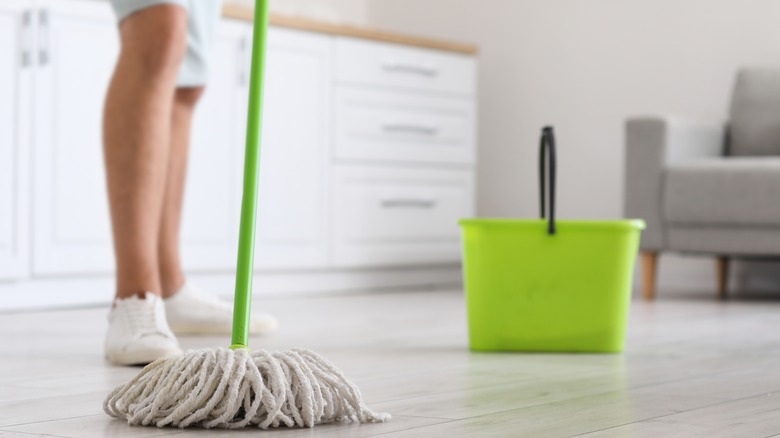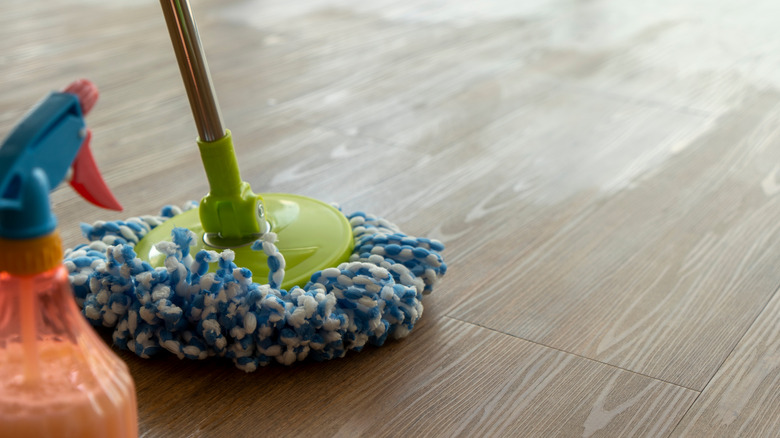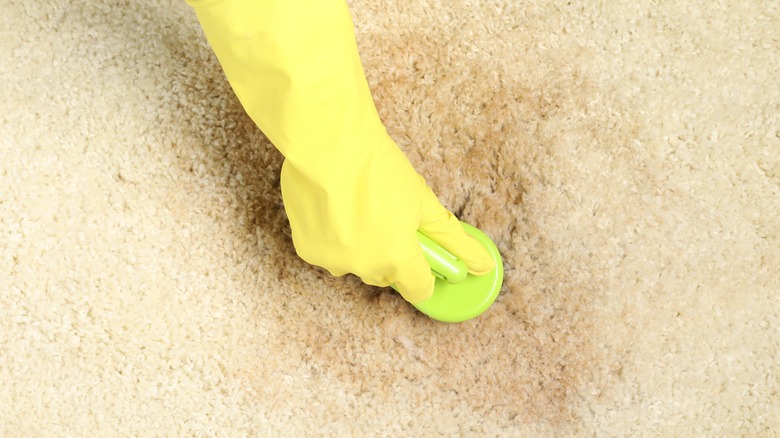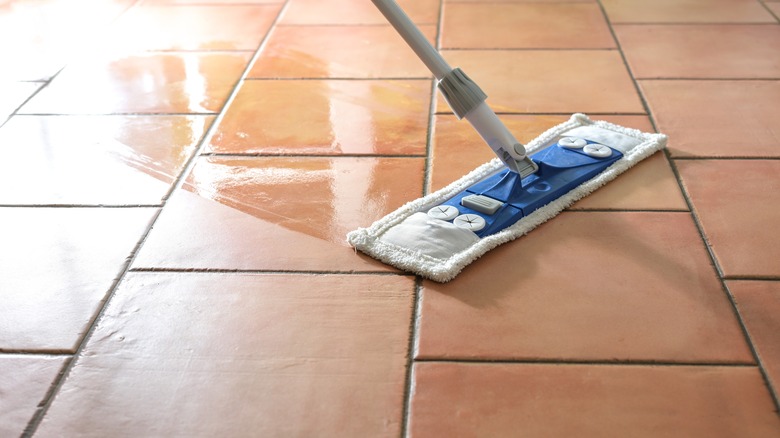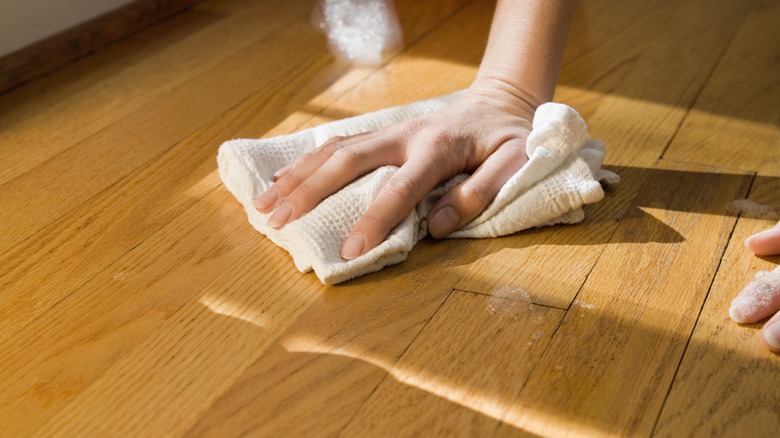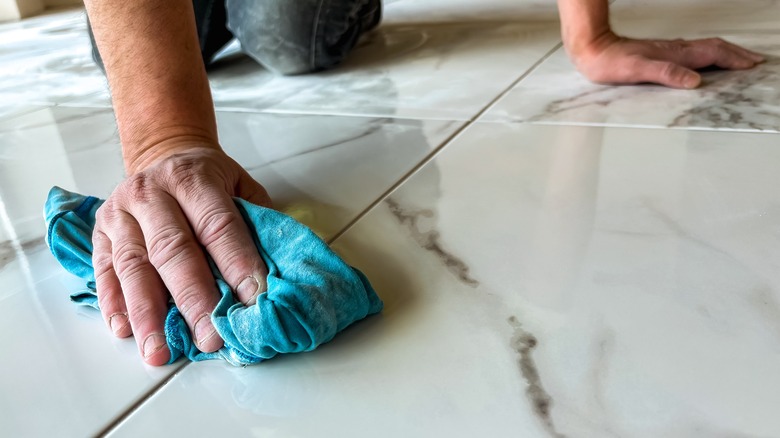Flooring You Should Be Mopping With Vinegar (& Ones To Avoid)
We may receive a commission on purchases made from links.
Vinegar is an incredibly popular cleaning agent. Its widespread appeal stems from its effectiveness at removing grime and its relatively mild, toxin-free composition. Vinegar gets its powers from its constituent acetic acid, which unbinds the grime and oil it comes in contact with. This property makes vinegar an excellent household ingredient to use for cleaning your floors. Surfaces that are not too affected by the solution's acidic nature — like vinyl, most carpets, and ceramic and porcelain tile— are the ideal candidates for vinegar-based cleaning.
That said, vinegar isn't suitable for use on every type of floor. In fact, some of the priciest flooring types, like hardwood and natural stone, should never be cleaned with this common household ingredient. That's because the acetic acid present in vinegar can degrade the finishes and sealants that protect these materials. Beyond the sealant, the acid can wreak havoc on the material itself by etching it via a chemical reaction. Below, we'll walk you through the best practices for using vinegar to clean various flooring types. You'll also learn how to maintain floors for which vinegar is not the recommended cleaning agent.
Vinegar is an effective cleaner for vinyl floors
Vinyl is a flooring type that's often made to resemble hardwood but at a fraction of the cost. This quality makes it a popular choice for homeowners. But another important benefit of this flooring type is its low maintenance requirements. In fact, one of the easiest ways to clean your vinyl floor is with a simple DIY solution like water and vinegar. You can make the water-vinegar cleaning agent by mixing 1 cup of vinegar — either white or apple cider — with a gallon of water. For best results, the water should be nice and warm.
Be sure to sweep the vinyl floors with a broom or dust mop before applying the vinegar solution. If you want to be more thorough, you can use a vacuum cleaner instead, and get in between the vinyl planks so that no dirt is left behind. Once all the loose debris is gone, you can move on to mopping. At this stage, it's important not to soak the floors with the solution, since excessive amounts of water can damage the vinyl planks. To avoid this scenario, make sure the mop is just moist enough — not completely wet. After you've mopped the entire floor area with the vinegar-water solution, mop a second time using water only. Rinsing the floors in this manner helps remove gunk that you miss during the first pass. Now, if you notice that some stains are not coming off even after the two rounds of mopping, try sprinkling baking soda on them, then rubbing them with a cloth.
Vinegar does a great job of lifting stains from carpet
There are two ways to clean carpet floors with vinegar. You can either use a vinegar-water mix, or apply vinegar and baking soda together (white vinegar only — its apple cider peer may leave a yellow stain). The first method works well for relatively light smears, especially ones that haven't had time to dry. Begin by blotting the stain with a dry cloth to get as much of the liquid out of the carpet's fibers. When you see that the cloth no longer absorbs the stain, mix water and vinegar with a 2-to-1 ratio and pour the liquid into a spray bottle. Next, spray the stain generously with the mix and let the vinegar soak through the fibers for a quarter-hour or so. Then blot the area with a clean, dry cloth to dry the carpet and remove the vinegar solution. If the stain proves particularly stubborn, either repeat the procedure or add baking soda to your arsenal.
When you use vinegar and baking soda together, you get the benefits of both substances. The acetic acid in the vinegar helps break down the residue, while the baking soda absorbs these particles. Begin by misting the stain with 1-to-1 water-vinegar. Then, cover the wet stain with baking soda. That's it — the concoction should start fizzling now, and all you need to do is sit back and let the two substances battle it out over the stain. After a full day, once the vinegar has dried completely, you can use a vacuum to get the baking soda out of the carpet's fibers. The stain should be gone with it.
Vinegar offers a safe way to clean ceramic and porcelain tile
Ceramic and porcelain tiles are only somewhat porous, so they don't get deep stains. That said, you'll find gunk building up on tiled floors that are subjected to heavy traffic, and vinegar is an excellent, natural way for removing the grime (along with any pathogens) from the tiles. Vinegar's acidity can definitely affect the tiles, but this natural cleaner is still less harsh than some of its commercial counterparts, and you can eliminate the risk of damage by diluting it properly with water. The ideal ratio is 1 cup of vinegar to roughly a gallon of hot water (the heat makes your DIY cleaning mix more potent).
Once you've swept or vacuumed the tiled floors, go ahead and mop them using the hot water and vinegar mixture. Take care not to make the floors too wet — you don't want it damaging the surrounding baseboards. Soaking the floors can also ruin the grout between the tiles, spur mold outbreaks, and cause the tiles to heave. So, wring the mop well before you wipe the surface, and repeat as necessary if stains refuse to come off the tiles. When you're satisfied with the floor's cleanliness, rinse the mop with pure water and give the surface another wipe. If some stains are not coming out at this point, coat them with a paste comprising baking soda and water. The paste should sit atop the stain for about 12 hours. Then you can pour a bit of vinegar on it and finally sweep the mix away with a brush or cloth. Hopefully, the combination of vinegar and soda is enough to lift the stain.
Avoid using vinegar on hardwood floors
Hardwood is one of the few flooring surfaces for which vinegar is not a suitable cleaning agent. Although vinegar is relatively mild compared to some commercially sold cleaners, it still contains acetic acid. This acid can harm the floors in two ways. Firstly, it can damage the protective layer that coats the hardwood. Damaging the hardwood finish leaves the wood itself exposed to dents and scratches and gradually robs the floor of its luxuriant, radiant look. Secondly, once the protective finish is breached, the acetic acid goes to work on the wood itself. After some time, you may notice that the wood has become etched. Considering that hardwood floors cost as much $8 per square foot, you don't want to cut corners and ruin yours by using a readily available — yet unsuitable — cleaner.
Instead of vinegar, clean your hardwood floors with a neutral pH agent, like this one from Bona. Neutral-pH cleaners are ideal for hardwood because they're neither acidic nor basic, and are gentle enough to not cause damage to either the finish or the wood itself. Once you've cleared the floor of any loose dirt by sweeping or vacuuming, spray them with the cleaner and wipe with a damp mop. Since hardwood floors are incredibly susceptible to water damage, don't make the mop wet, and never allow water to pool on the floor surface. For best results, use a microfiber cloth to wipe the floor instead of a traditional mop. The microfiber fabric doesn't get as wet as regular mops do, so it poses less of a risk to your precious hardwood.
Vinegar is not ideal for natural stone, like marble, granite, and terracotta
If you have natural stone floors at home, you may be tempted to reach for a versatile cleaning tool like vinegar to mop them with. Don't. While vinegar is your go-to cleaning agent for a whole host of flooring surfaces, the same acidic properties that give it its cleaning prowess make it a destructive substance for natural stone floors. The acetic acid can degrade the sealant and ruin the tiles themselves. If your floors are made of marble or limestone, the vinegar will react with the calcium carbonate in the stone and cause etching, which leaves dull blemishes on the stone. Even if you're working with heavier-duty granite floors, an acidic cleaner like vinegar can damage their protective sealant.
The best way to clean natural stone floors is with a neutral-pH agent, like this one from The Home Depot. This type of cleaner does not react with stone, nor does it degrade the sealant. To clean your stone floors with this agent, follow the manufacturer's instructions and avoid using scouring pads, hard-bristle brushes, or similar items in the process. Crucially, dry the floors right away after cleaning so that they don't absorb any liquids and develop stains. Preventative maintenance goes a long way in protecting your stone floors' innate glory. So, clean the floors often to prevent the build-up of dirt and grime, and consider resealing them as needed to maintain their protective shield against stains.
